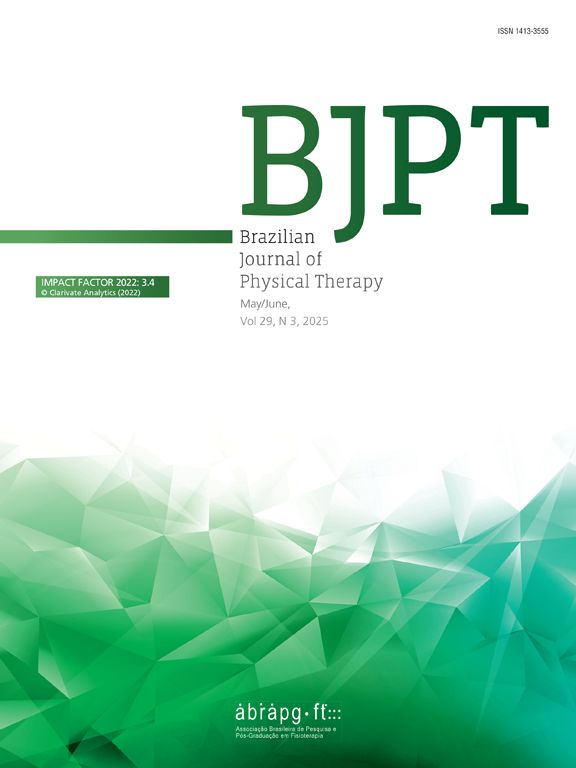7655
Misconceptions of physical therapists and medical doctors regarding the impact of lifting a light load on low back painJoséphine Rialet-Micoulau, Valoris Lucas, Christophe Demoulin, Laurent Pitance
Braz J Phys Ther. 2022;26:100385
7655
Highlights
- •
Beliefs that some strategies to lift a light load may be harmful are common among health care professionals, particularly medical students and doctors.
- •
The majority of qualified physical therapists are aware that all strategies used to lift a light load are safe.
- •
Taking a pain education course positively impacts physical therapists’ attitudes and beliefs.
7159
Which psychosocial factors are related to severe pain and functional limitation in patients with low back pain?Leticia Amaral Corrêa, Stephanie Mathieson, Ney Armando de Mello Meziat-Filho, Felipe José Reis, Arthur de Sá Ferreira, Leandro Alberto Calazans Nogueira
Braz J Phys Ther. 2022;26:100413
7159
HIGHLIGHTS
- •
Cognitive factors are related to unfavourable clinical outcomes in patients with LBP.
- •
Kinesiophobia, catastrophizing, and maladaptive beliefs played a negative role in LBP.
- •
Anxiety, symptoms of depression, and perceived stress were not linked to severe pain.
6741
The impact of digital physical therapy during COVID-19 lockdown in children with developmental disorders: A qualitative studyAlicia Portillo-Aceituno, Andrea Calderón-Bernal, Jorge Pérez-Corrales, César Fernández-de-las-Peñas, Domingo Palacios-Ceña, Javier Güeita-Rodríguez
Braz J Phys Ther. 2022;26:100445
6741
Highlights
- •
Digital physical therapy may be a solution for continuity during lockdown, yet its development appears complex.
- •
Implementation difficulties seem to relate to physical, attentional, and training factors.
- •
Technological accessibility, adaptation of the therapist and involvement of the whole family appear to be facilitators.
- •
Future possibilities may support a better follow-up with fluid communication between families and therapists.
6522
Patients should not rely on low back pain information from Brazilian official websites: A mixed-methods reviewRaiany Pires Santos, Thamires Prazeres Alonso, Igor Macedo Tavares Correia, Leandro Calazans Nogueira, Ney Meziat-Filho, Felipe J.J. Reis
Braz J Phys Ther. 2022;26:100389
6522
Highlights
- •
Patients should not rely on low back pain information from Brazilian official websites.
- •
The Brazilian official websites do not follow the recommendations from clinical practice guidelines.
- •
Brazilian official websites show low credibility standards and inaccurate information about low back pain.
6098
Shared decision making and physical therapy: What, when, how, and why?Tammy Hoffmann, Mina Bakhit, Zoe Michaleff
Braz J Phys Ther. 2022;26:100382
6098
Highlights
- -
Shared decision making helps to translate evidence into practice.
- -
It can improve communication and accuracy of intervention expectations.
- -
Physical therapists are ideally positioned to practice shared decision making.
- -
Shared decision making is a skill that should be taught to clinicians.
- -
Strategies to increase its uptake are required at multiple levels.
6038
Photobiomodulation therapy applied during an exercise-training program does not promote additional effects in trained individuals: A randomized placebo-controlled trialAryane F. Machado, Ernesto Cesar P. Leal-Junior, Natanael P. Batista, Rafael M.C.P.P. Espinoza, Rodolfo B.R. Hidalgo, Flavia A. Carvalho, Jéssica K. Micheletti, Franciele M. Vanderlei, Carlos Marcelo Pastre
Braz J Phys Ther. 2022;26:100388
6038
Highlights
- •
No evidence was found that photobiomodulation applied during combined training promote any additional effects.
- •
Participants already adapted to a specific stimulus or previously trained do not benefit from the use of photobiomodulation for recovery.
- •
Photobiomodulation was not superior to placebo and control on functional, clinical, and systemic outcomes.
5810
Physical therapists and public perceptions of telerehabilitation: An online open survey on acceptability, preferences, and needsLívia G. Fernandes, Rafael F.F. Oliveira, Pamela M. Barros, Felipe R.C. Fagundes, Renato J. Soares, Bruno T. Saragiotto
Braz J Phys Ther. 2022;26:100464
5810
Highlights
- •
Physical therapists and the general population are hesitant in using telerehabilitation. Concerns include, but are not limited to, the financial worth of telerehabilitation.
- •
Physical therapists agree with the provision of education and self-management strategies via telerehabilitation, but the general population highlights the need for exercise prescription and technical orientation on exercise performance.
- •
Practical recommendations and adequate training are needed to address physical therapists’ acceptability to telerehabilitation. For the general population, gradual exposure to telerehabilitation could enhance engagement with this mode of delivering physical therapy.
5808
Scapulothoracic muscle activity during kinetic chain variations of a prone elevation exerciseDorien Borms, Annelies Maenhout, Kelly Berckmans, Valentien Spanhove, Fran Vanderstukken, Ann Cools
Braz J Phys Ther. 2022;26:100420
5808
Highlights
- •
Challenging the kinetic chain influences upper trapezius muscle activity.
- •
Adding external rotation resistance decreases upper trapezius activity.
- •
Adding trunk extension increases upper trapezius activity.
- •
Changing exercise position does not change scapular muscle activity.
5743
Rehabilitation 2030: a collective call that requires individual actionJeff Hartman, Antony Duttine
Braz J Phys Ther. 2022;26:100360
5743
Highlights
- •
Physical therapy is part of a larger rehabilitation community promoting social justice and health equity.
- •
Rehabilitation is not only for persons with disability.
- •
Greater access to physical therapy and rehabilitation services would help “ensure healthy lives and promote well-being at all ages”.
- •
“Rehabilitation 2030″ is a call to fulfill the basic human right to health and wellbeing, and all physical therapists have a role to play.
5545
Effects of pulsed electromagnetic field therapy on fatigue, walking performance, depression, and quality of life in adults with multiple sclerosis: a randomized placebo-controlled trialAnabel Granja-Domínguez, Anja Hochsprung, Carlos Luque-Moreno, Eleonora Magni, Shahid Escudero-Uribe, Beatriz Heredia-Camacho, Guillermo Izquierdo-Ayuso, Alberto Marcos Heredia-Rizo
Braz J Phys Ther. 2022;26:100449
5545
Highlights
- •
Electromagnetic field therapy did not have an impact on multiple sclerosis-related fatigue in adults with minimal to significant disability.
- •
The effect of electromagnetic fields was similar to placebo for measures of walking performance.
- •
Magnetic field therapy did not evoke changes in depressive symptoms or quality of life.
5483
Sedentary behavior is associated with musculoskeletal pain in adolescents: A cross sectional studyLucas da Costa, Italo Ribeiro Lemes, William R. Tebar, Crystian B. Oliveira, Paulo H. Guerra, José Luiz G. Soidán, Jorge Mota, Diego.G.D. Christofaro
Braz J Phys Ther. 2022;26:100452
5483
Highlights
- •
The prevalence of sedentary behavior among adolescents was high.
- •
Boys with moderate sedentary behavior were 2.7 times more likely to have neck pain when compared to those with low sedentary behavior. Similar findings were observed for girls.
- •
Girls with moderate and high sedentary behavior were 2.5 times more likely to have low back pain.





